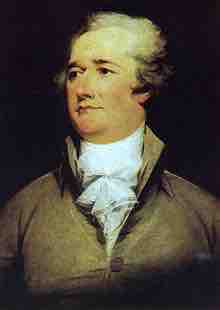The Federalist Era was a period in American history from roughly 1789-1801 when the Federalist Party was dominant in American politics. This period saw the adoption of the United States Constitution and the expansion of the federal government. In addition, the era saw the growth of a strong nationalistic government under the control of the Federalist Party. Among the most important events of this period were the foreign entanglements between France and Great Britain, the assertion of a strong centralized federal government, and the creation of political parties. The First Party System of the United States featured the Federalist Party and the Democratic-Republican Party (also known as the Anti-Federalist Party).
The United States Constitution was written in 1787 and unanimously ratified by the states in 1788, taking effect in 1789. The winning supporters of ratification of the Constitution were called Federalists and the opponents were called Anti-Federalists. The immediate problem faced by the Federalists was not simply one of acceptance of the Constitution but the more fundamental concern of legitimacy for the government of the new republic. With this challenge in mind, the new national government needed to act with the idea that every act was being carried out for the first time and would therefore have great significance and be viewed along the lines of the symbolic as well as practical implications. The first elections to the new United States Congress returned heavy Federalist majorities. The first Anti-Federalist movement opposed the draft Constitution in 1788, primarily because they lacked a Bill of Rights. The Anti-Federalists, or Democrat-Republicans, objected to the new powerful central government and the loss of prestige for the states, and saw the Constitution as a potential threat to personal liberties. During the ratification process the Anti-Federalists presented a significant opposition in all but three states. A major stumbling block for the Anti-Federalists, however, was that the supporters of the Constitution were more deeply committed and outmaneuvered the less energetic opposition.
Federalists v. Anti-Federalists
The dynamic force in the Presidency of George Washington was the secretary of the treasury, Alexander Hamilton . Hamilton had the vision of a strong national government and a strong national economy. He devised a complex multi-faceted program to achieve that goal and simultaneously solved the debt problem for most of the states. Hamilton created a financial system for national and international stability that included paying off the national debt and laying the infrastructure for further economic development. Hamilton's programs included:

Alexander Hamilton
Alexander Hamilton, secretary of treasury under President George Washington, became a leading Federalist in the Federalist vs. Anti-Federalists debate.
- the assumption of the state's Revolutionary War debts;
- the payoffs of the debts of the old Continental Congress;
- the payoffs of loans from foreign treasuries and investors;
- the creation of a system of taxes and tariffs to pay for the debt; and
- a First Bank of the United States to handle the finances.
Congress approved Hamilton's programs, which would later be labeled Federalist, over the opposition of the old Anti-Federalists element, which increasingly coalesced under the leadership of Thomas Jefferson and James Madison. In order to build a national network in support of his programs, Hamilton created a coalition of supporters in every city and state, often consisting of prominent businessmen and financiers. Hamilton's network of supporters grew into the "Federalist Party" that included most, but not all, of those Federalists who supported the Constitution in 1788. A major emphasis of Hamilton's policies and indeed the general outlook for the Federalist Party was that the federal government was to preside over the national economy.
Rise of political parties
Federalists during the ratification period had been unified around the Constitution and support for its form of government. Following the acceptance of the Constitution, the initial Federalist movement faded briefly only to be taken up by a second movement centered upon the support for Alexander Hamilton's policies of a strong nationalist government, loose construction of the Constitution, and mercantile economic policies. The support around these policies eventually established the first official political party in the United States as the Federalist Party. The Party reached its political apex with the election of the strongly Federalist President John Adams. However the defeat of Adams in the election of 1800 and the death of Hamilton led to the decline of the Federalist Party from which it did not recover. While there were still Federalists after 1800, the party never again enjoyed the power and influence it had held earlier. One of the Federalists Era's greatest accomplishments was that republican government survived and took root in the United States.
Republicans, or the Democratic-Republican Party, was founded in 1792 by Jefferson and James Madison. The party was created in order to oppose the policies of Hamilton and the Federalist Party. In contrast to the Federalists, the Republican supported a strict construction interpretation of the Constitution, and denounced many of Hamilton's proposals (especially the national bank) as unconstitutional. The party promoted states' rights and the primacy of the yeoman farmer over bankers, industrialists, merchants, and other monied interests. The party supported states' rights as a measure against the tyrannical nature of a large centralized government that they feared the Federal government could have easily become. It would be Jefferson and the Republican Party that would replace the Federalist Party domination of politics following the election of 1800.